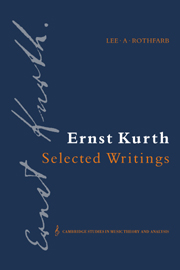Book contents
- Frontmatter
- Contents
- Foreword by Ian Bent
- Preface
- Notes on the translation
- Introduction
- Part I Grundlagen des linearen Kontrapunkts (Foundations of linear counterpoint)
- Part II Romantische Harmonik und ihre Krise in Wagners “Tristan” (Romantic harmony and its crisis in Wagner's “Tristan”)
- Part III Bruckner
- 6 Bruckner's form as undulatory phases
- 7 Details of Bruckner's symphonic waves
- Appendix: Complete tables of contents for Kurth's Grundlagen des linearen Kontrapunkts, Romantische Harmonik und ihre Krise in Wagners “Tristan” and Bruckner
- Select bibliography
- Index of musical examples
- General index
7 - Details of Bruckner's symphonic waves
Published online by Cambridge University Press: 10 December 2009
- Frontmatter
- Contents
- Foreword by Ian Bent
- Preface
- Notes on the translation
- Introduction
- Part I Grundlagen des linearen Kontrapunkts (Foundations of linear counterpoint)
- Part II Romantische Harmonik und ihre Krise in Wagners “Tristan” (Romantic harmony and its crisis in Wagner's “Tristan”)
- Part III Bruckner
- 6 Bruckner's form as undulatory phases
- 7 Details of Bruckner's symphonic waves
- Appendix: Complete tables of contents for Kurth's Grundlagen des linearen Kontrapunkts, Romantische Harmonik und ihre Krise in Wagners “Tristan” and Bruckner
- Select bibliography
- Index of musical examples
- General index
Summary
Our chapter 7 continues the translations begun in chapter 6, from Bruckner, part 2, chapter 2. As explained in the introductory paragraphs to our chapter 6, part 2 of Bruckner contains a series of preliminary analyses that initiate the reader into Kurth's style of analysis, and provide a framework for understanding the extended discussions of each movement of the symphonies, as well as of Bruckner's other major works, in volume 2 of Bruckner.
In our chapter 6, the discussions of excerpts from the first and last movements of the Sixth Symphony, and from the second movement of the Fourth, gave us the basic idea of Kurth's approach to form. The analytical discussions included below probe further into the details of dynamic formal processes. Kurth addresses reverberatory waves (Nachbebungen, literally “after-tremors”) in a short excerpt from the first movement of the Ninth Symphony (Ex. 7.1). Two passages from the first movement of the Fifth illustrate how Bruckner creates a sense of symphonic space (Exx. 7.2, 7.3), and an excerpt from the second movement of the Seventh shows how formal dynamics affect developmental motives (Ex. 7.4). Finally, the opening of the first movement of the Eighth Symphony illustrates thematic-motivic evolution and the effect of formal dynamics on harmony (Exx. 7.5–7.8). My notes refer to other, perhaps more familiar analyses of the opening of the Eighth in publications by Hugo Leichtentritt, Werner Korte, and Constantin Floros.
- Type
- Chapter
- Information
- Ernst Kurth: Selected Writings , pp. 188 - 207Publisher: Cambridge University PressPrint publication year: 1991
- 1
- Cited by



